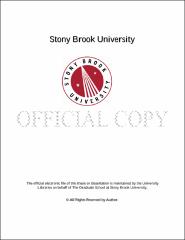| dc.identifier.uri | http://hdl.handle.net/11401/77058 | |
| dc.description.sponsorship | This work is sponsored by the Stony Brook University Graduate School in compliance with the requirements for completion of degree. | en_US |
| dc.format | Monograph | |
| dc.format.medium | Electronic Resource | en_US |
| dc.language.iso | en_US | |
| dc.publisher | The Graduate School, Stony Brook University: Stony Brook, NY. | |
| dc.type | Dissertation | |
| dcterms.abstract | There has been considerable and growing interest in the field of stimulus-responsive polymers over the last two decades, as they can be exploited in many applications including biomedicine, sensing, and separations. Temperature remains the most extensively investigated physical stimulus due to its ease of application and monitoring. In this dissertation, a new class of thermally responsive ABC poly(ethylene oxide)-block-poly(N,N-diethylacrylamide)-block-poly(N,N-dibutylacrylamide) (PEO-b-PDEAm-b-PDBAm) triblock copolymers has been synthesized by reversible addition−fragmentation chain-transfer (RAFT) polymerization. In aqueous solution, PEO-b-PDEAm-b-PDBAm copolymers self-assemble into a wide range of different aggregated structures including spherical micelles, cylindrical micelles, vesicles and large compound micelles. The precise morphology mainly depends on the relative volume fractions of the hydrophilic and hydrophobic blocks. The fast rate (within 10 minutes) of reversible thermally induced change in triblock copolymer morphologies was confirmed by dynamic light scattering (DLS) and transmission electron microscopy (TEM). The enhanced rate further supports the hypothesis that the absence of strong interchain hydrogen bonding in the central thermally responsive block will accelerate the rearrangement. Moreover, we also designed a novel rapidly reversible thermoresponsive ABC triblock copolymer worm gel, resulting from a sphere-to-worm transition at temperatures above the lower critical solution temperature (LCST) of the PDEAm block. A preliminary experiment was also conducted, confirming the successful encapsulation of a hydrophilic dye Rhodamine B into the large compound micelles formed upon heating. | |
| dcterms.abstract | There has been considerable and growing interest in the field of stimulus-responsive polymers over the last two decades, as they can be exploited in many applications including biomedicine, sensing, and separations. Temperature remains the most extensively investigated physical stimulus due to its ease of application and monitoring. In this dissertation, a new class of thermally responsive ABC poly(ethylene oxide)-block-poly(N,N-diethylacrylamide)-block-poly(N,N-dibutylacrylamide) (PEO-b-PDEAm-b-PDBAm) triblock copolymers has been synthesized by reversible addition−fragmentation chain-transfer (RAFT) polymerization. In aqueous solution, PEO-b-PDEAm-b-PDBAm copolymers self-assemble into a wide range of different aggregated structures including spherical micelles, cylindrical micelles, vesicles and large compound micelles. The precise morphology mainly depends on the relative volume fractions of the hydrophilic and hydrophobic blocks. The fast rate (within 10 minutes) of reversible thermally induced change in triblock copolymer morphologies was confirmed by dynamic light scattering (DLS) and transmission electron microscopy (TEM). The enhanced rate further supports the hypothesis that the absence of strong interchain hydrogen bonding in the central thermally responsive block will accelerate the rearrangement. Moreover, we also designed a novel rapidly reversible thermoresponsive ABC triblock copolymer worm gel, resulting from a sphere-to-worm transition at temperatures above the lower critical solution temperature (LCST) of the PDEAm block. A preliminary experiment was also conducted, confirming the successful encapsulation of a hydrophilic dye Rhodamine B into the large compound micelles formed upon heating. | |
| dcterms.available | 2017-09-20T16:51:48Z | |
| dcterms.contributor | Koch, Stephen A. | en_US |
| dcterms.contributor | Grubbs, Robert B. | en_US |
| dcterms.contributor | Hsiao, Benjamin S. | en_US |
| dcterms.contributor | Pietrangelo, Agostino. | en_US |
| dcterms.creator | Sun, Zhe | |
| dcterms.dateAccepted | 2017-09-20T16:51:48Z | |
| dcterms.dateSubmitted | 2017-09-20T16:51:48Z | |
| dcterms.description | Department of Chemistry | en_US |
| dcterms.extent | 153 pg. | en_US |
| dcterms.format | Application/PDF | en_US |
| dcterms.format | Monograph | |
| dcterms.identifier | http://hdl.handle.net/11401/77058 | |
| dcterms.issued | 2016-12-01 | |
| dcterms.language | en_US | |
| dcterms.provenance | Made available in DSpace on 2017-09-20T16:51:48Z (GMT). No. of bitstreams: 1
Sun_grad.sunysb_0771E_12998.pdf: 12975304 bytes, checksum: 994996e5e17caaf72773ef460148e200 (MD5)
Previous issue date: 1 | en |
| dcterms.publisher | The Graduate School, Stony Brook University: Stony Brook, NY. | |
| dcterms.subject | Chemistry | |
| dcterms.subject | encapsulation, hydrogel, self-assembly, thermally responsive polymer | |
| dcterms.title | Understanding Structure and Response in Thermally Responsive Block Copolymer Assemblies | |
| dcterms.type | Dissertation | |

